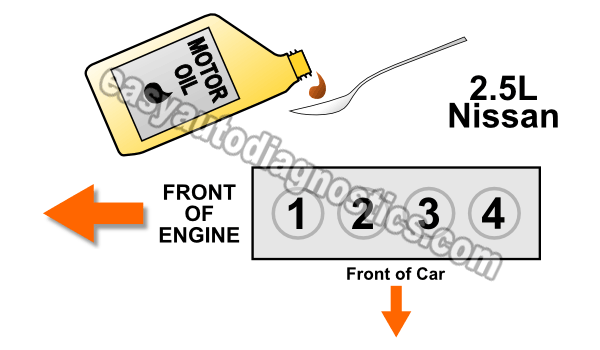Interpreting The Results Of The Engine Compression Test
There's a good chance that the compression values you wrote down for each cylinder are slightly different from one another. This could normal and nothing to worry about yet or it could be a problem.
What could cause a problem is if the cylinder compression values vary too much. The cool thing is that we can find out if the variations in the values, you wrote down, indicate a problem (with that cylinder) or not.
The rule of thumb is that they can not vary more than 15% from each other and if they do, you're gonna' have a genuine misfire condition on your hands or possibly a no-start condition (if more than one cylinder is affected).
How do you figure this out? You can find out by using my online low compression calculator here: Online Low Engine Compression Calculator or manually this way:
- STEP 1: Multiply the highest compression value by 0.15 (this is the decimal value of 15%).
- STEP 2: Round the result to the nearest one (for example: 25.6 would become 26).
- STEP 3: Subtract the result (the number that was rounded) from the highest compression value.
- ANSWER: The result of this subtraction is the lowest possible compression value any cylinder can have.
To make better sense of the above calculation, let's say that my 2.5L Altima produced the following compression test results:
| Cylinder | Pressure |
|---|---|
| #1 | 175 PSI |
| #2 | 170 PSI |
| #3 | 165 PSI |
| #4 | 120 PSI |
The next step is to do the math:
- STEP 1: 175 x 0.15 = 26.25.
- STEP 2: 26.25 = 26.
- STEP 2: 175 - 26= 149.
- ANSWER: 149 PSI is the lowest possible compression value.
Since cylinder #4 is producing 120 PSI, I can conclude that it's the one causing the misfire. The next step is to find out what's causing the low compression value. Go to: TEST 2: Wet Compression Test.
TEST 2: Wet Compression Test

If in TEST 1 you got one (or more cylinders) with very low engine compression, your next step is to do a 'wet' engine compression test.
The wet compression test will help you pinpoint the problem (of the low compression test result) to the cylinder head valves or the piston rings.
Doing a wet engine compression test simply involves adding about 1 to 2 tablespoons of motor oil to the cylinder with low compression and then check its compression once again (with your compression tester).
At the bottom, I'll show you how to interpret your test results.
OK, this is what you'll need to do:
- 1
Add a tablespoon of engine oil in the cylinder you need to retest. I suggest using a small and long funnel so that the oil will reach the inside of the cylinder.
- 2
Once you've added the oil, install the compression gauge and as before just hand tighten it.
- 3
Now, have your helper crank the engine till the needle stops climbing on the compression gauge.
- 4
You'll see one of two results:
1.) The needle will climb higher than the previous compression number you recorded for this specific cylinder.
2.) The needle will not move at all or stay at the same number you recorded earlier.
Whatever value your compression tester reads, write it down again. - 5
Repeat steps 1 thru' 4 on any other cylinder that gave you a low compression value.
Let's take a look at what your compression test results mean:
CASE 1: The compression tester registered a higher value. This compression test result confirms that the low compression value registered in this cylinder in the dry test is due to worn piston rings.
CASE 2: The compression tester DID NOT register a higher value (than the previous recorded value). This result tells you that the low compression value registered in this cylinder in the dry test is due to worn/damaged cylinder head valves.
Related Test Articles
To see all of the 2.5L Nissan specific articles, go to: Nissan 2.5L Index Of Articles.
Here's a sample of the articles, you'll find in the Index of Articles:
- Coil-On-Plug (COP) Coil Test 2.5L Nissan Altima, Sentra (2002-2006).
- How To Test The Fuel Injectors (2.5L Nissan Altima, Sentra).
- Testing A Bad Alternator: Symptoms And Diagnosis.
- How To Bench Test The Starter Motor.
- How To Troubleshoot a Blown Head Gasket (2.5L) (at: troubleshootmyvehicle.com).

If this info saved the day, buy me a beer!


